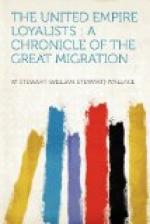It is not possible here to give more than a brief sketch of the operations of these troops. In 1777 they formed an important part of the forces with which General Burgoyne, by way of Lake Champlain, and Colonel St Leger, by way of Oswego, attempted, unsuccessfully, to reach Albany. An offshoot of the first battalion of the ’Royal Greens,’ known as Jessup’s Corps, was with Burgoyne at Saratoga; and the rest of the regiment was with St Leger, under the command of Sir John Johnson himself. The ambuscade of Oriskany, where Sir John Johnson’s men first met their Whig neighbours and relatives, who were defending Fort Stanwix, was one of the bloodiest battles of the war. Its ‘fratricidal butchery’ denuded the Mohawk valley of most of its male population; and it was said that if Tryon county ’smiled again during the war, it smiled through tears.’ The battle was inconclusive, so bitterly was it contested; but it was successful in stemming the advance of St Leger’s forces.
The next year (1778) there was an outbreak of sporadic raiding all along the border. Alexander Macdonell, the former aide-de-camp of Bonnie Prince Charlie, fell with three hundred Loyalists on the Dutch settlements of the Schoharie valley and laid them waste. Macdonell’s ideas of border warfare were derived from his Highland ancestors; and, as he expected no quarter, he gave none. Colonel Butler, with his Rangers and a party of Indians, descended into the valley of Wyoming, which was a sort of debatable ground between Connecticut and Pennsylvania, and carried fire and sword through the settlements there. This raid was commemorated by Thomas Campbell in a most unhistorical poem entitled Gertrude of Wyoming:
On Susquehana’s side, fair
Wyoming!
Although the wild-flower on thy
ruined wall
And roofless homes a sad remembrance
bring
Of what thy gentle people did befall.
Later in the year Walter Butler, the son of Colonel John Butler, and Joseph Brant, with a party of Loyalists and Mohawks, made a similar inroad on Cherry Valley, south of Springfield in the state of New York. On this occasion Brant’s Indians got beyond control, and more than fifty defenceless old men, women, and children were slaughtered in cold blood.
The Americans took their revenge the following year. A large force under General Sullivan invaded the settlements of the Six Nations Indians in the Chemung and Genesee valleys, and exacted an eye for an eye and a tooth for a tooth. They burned the villages, destroyed the crops, and turned the helpless women and children out to face the coming winter. Most of the Indians during the winter of 1779-80 were dependent on the mercy of the British commissaries.




